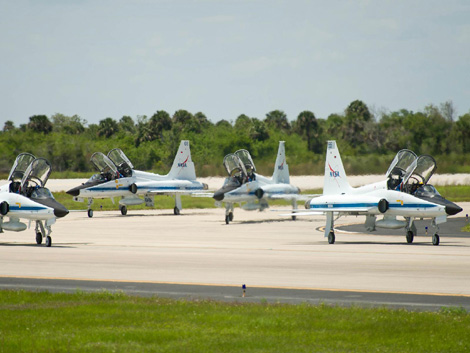The Astronauts’ Ride
Strange days for NASA’s astronauts
Strange days for NASA’s astronauts. Their numbers are down—from a peak of 150 in 2000 to just over 60 today. And they just lost their main vehicle, the space shuttle. For a few years, they’ll be passengers on somebody else’s spaceship, which on some level must rankle.

My other car was a shuttle: The STS-134 astronauts arrive in Florida in T-38s before their launch last April.
It seems heartless, then, to suggest that the astronauts’ cherished T-38Ns—the sporty, two-seater training jets they use to keep their piloting skills sharp and their commute from Houston to Cape Canaveral short—should be yanked away too. Nobody has proposed that directly, or at least publicly. But eyebrows have been raised. Do the astronauts really need all those T-38s (NASA maintains a fleet of 21, which will soon drop to 16) when nobody will be doing much piloting in the near future?
The answer, in a National Research Council report on the astronaut corps published this week, is yes. It turns out that T-38s serve more of a purpose than just making the astronauts look cool when they arrive in Florida before a launch. From the report:
It is important to emphasize that SFRT is not just about flying the T-38N as the pilot in command. Instead, it is about developing the skills and ability to work together in an environment that is fast-paced, physically stressful, and carries potentially severe penalties for failure. SFRT involves both the pilot in command of the aircraft and the person in the back seat, dividing responsibilities. For example, the backseat flyer frequently handles navigation, communications, and crew resource management duties during flight and must coordinate with the pilot, who is actually flying the aircraft. Hands-on control of the aircraft by backseaters is a big part of SFRT. SFRT is useful for many aspects of spaceflight⎯not only for operation of a spacecraft such as Soyuz, but also for operations onboard the International Space Station….Given the current investment in the existing T-38N fleet, in the near term that fleet is the most cost-effective means for providing SFRT.
There’s more good news for astronauts in the report. The NRC endorses NASA’s plan for keeping the corps at about 60, which may seem high when only two Americans typically are on the space station at any one time. But when you consider, as the report does, all of the constraints on crew readiness, from medical issues to training requirements (it takes longer to train for a space station mission than for a shuttle flight), 60 people seems about right. If anything, the NRC panel says, it’s a little thin. NASA plans to hire 15 more astronauts in the next five years, with selections in 2012 and 2014.